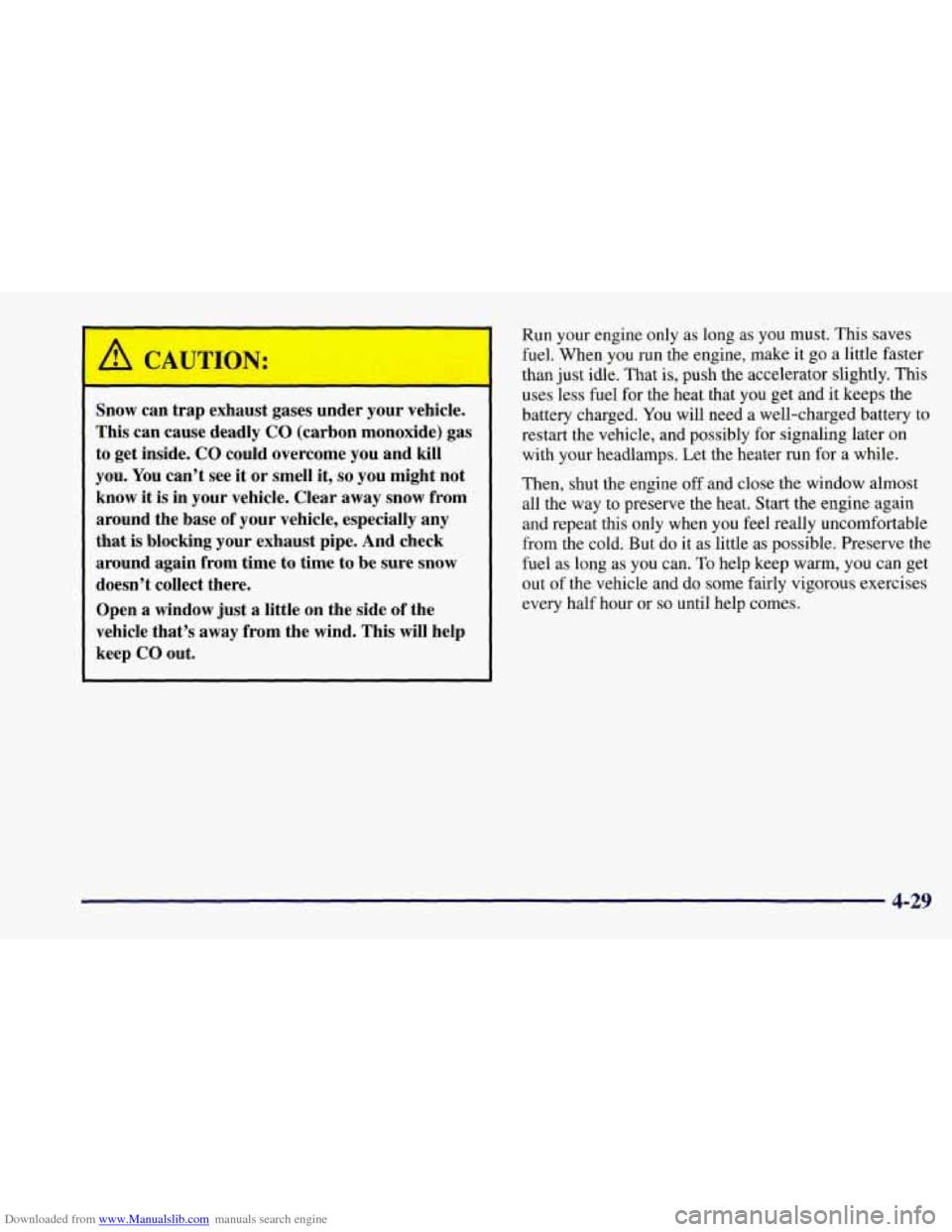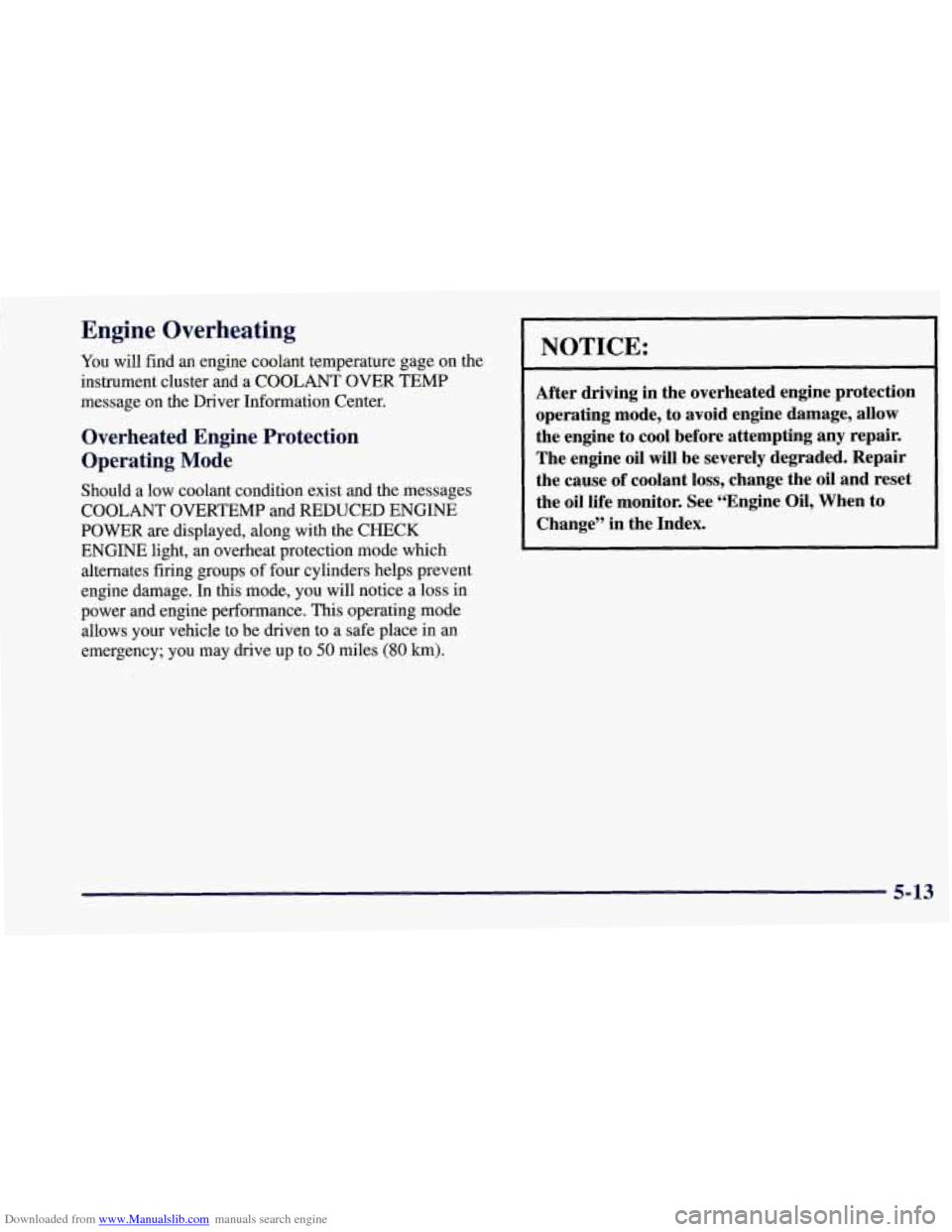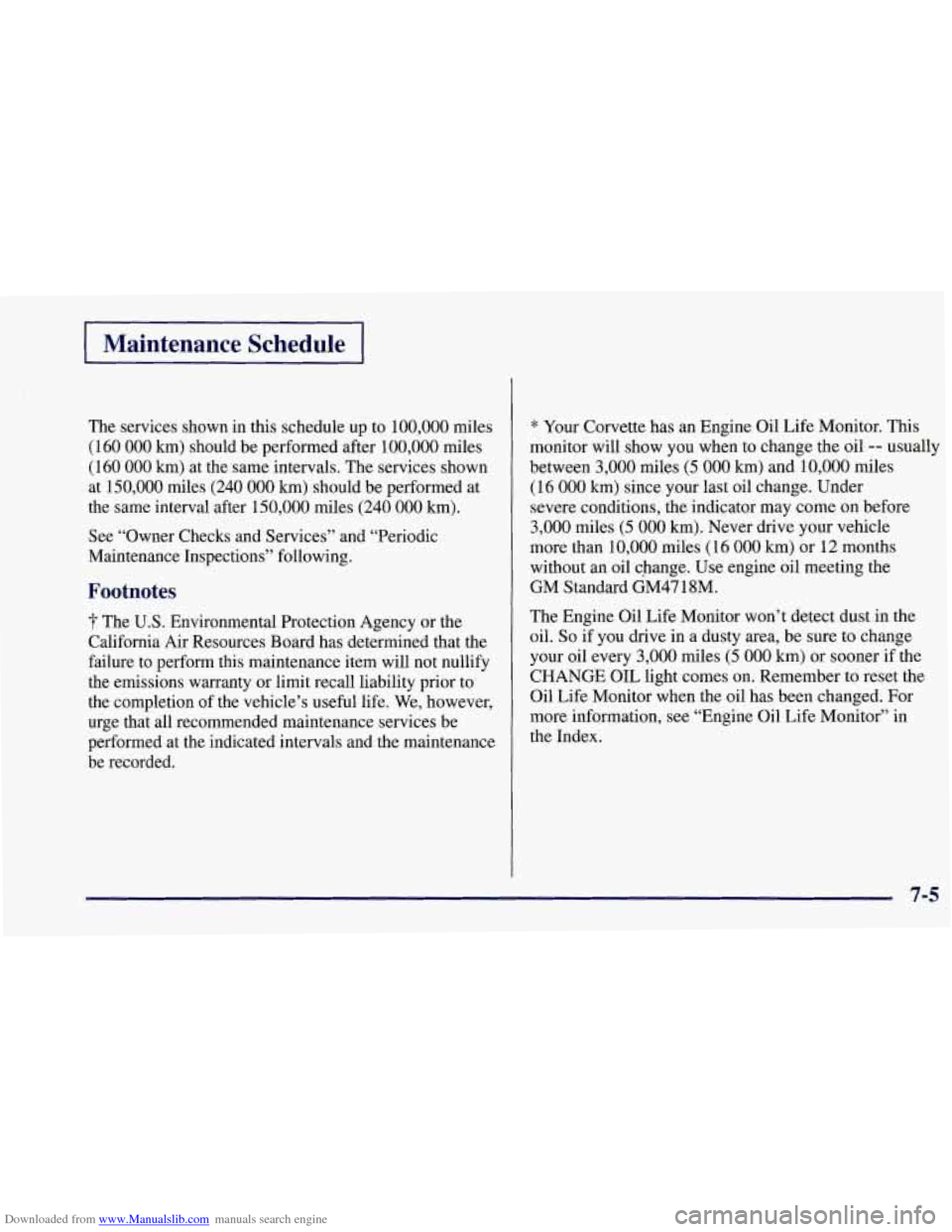1997 CHEVROLET CORVETTE check engine light
[x] Cancel search: check engine lightPage 202 of 356

Downloaded from www.Manualslib.com manuals search engine Once you are moving on the freeway, make certain you
allow a reasonable following distance. Expect
to move
slightly slower at night.
When you want to leave the freeway, move to the proper
lane well in advance. If you miss your exit, do not,
under any circumstances, stop and back up. Drive on
to
the next exit.
The exit ramp can be curved, sometimes quite sharply.
The exit speed
is usually posted.
Reduce your speed according to your speedometer, not to your sense of moti0.n. After driving for any distance
at higher speeds, you may tend to think you are going
slower than you actually
are.
Before Leaving on a Long Trip
Make sure you’re ready. Try to be well rested. If you
must start when you’re not fresh
-- such as after a day’s
work
-- don’t plan to make too many miles that first part
of the journey. Wear comfortable clothing and shoes you
can easily drive in.
Is your vehicle ready for a long trip? If you keep it
serviced and maintained, it’s ready to go. If it needs
service, have it done before starting out. Of course,
you’ll find experienced and able service experts in
Chevrolet dealerships all across
North America. They’ll
be ready and willing to help if you need it.
Here are some things you can check before a trip:
0
0
0
0
0
0 0
Windshield Washer Fluid: Is the reservoir full? Are
all windows clean inside and outside?
Wiper Blades: Are they in good shape?
Fuel, Engine Oil, Other Fluids: Have you checked
all levels?
Lamps: Are they all working? Are the lenses clean?
Tires: They are vitally important to a safe,
trouble-free trip. Is the tread good enough for
long-distance driving?
Are the tires all inflated to the
recommended pressure?
Weather Forecasts: What’s the weather outlook
along your route? Should you delay your trip a short
time to avoid a major storm system?
Maps: Do you have up-to-date maps?
4-23
Page 208 of 356

Downloaded from www.Manualslib.com manuals search engine Snow can trap exhaust gases under your vehicle.
This can cause deadly
CO (carbon monoxide) gas
to get inside.
CO could overcome you and kill
you. You can’t see it or smell it, so you might not
know it
is in your vehicle. Clear away snow from
around the base of your vehicle, especially any
that
is blocking your exhaust pipe. And check
around again from time to time to be sure
snow
doesn’t collect there.
Open a window just
a little on the side of the
vehicle that’s away from the wind. This will help
keep
CO out.
I Run your engine only as long as you must. This saves
fuel. When you run the engine, make it
go a little faster
than just idle. That is, push the accelerator slightly. This
uses less fuel for the heat that you get and it keeps the
battery charged. You will need a well-charged battery to
restart the vehicle, and possibly for signaling later on
with your headlamps. Let the heater run for a while.
Then, shut the engine off and close the window almost
all the way to preserve the heat. Start the engine again
and repeat this only when you feel really uncomfortable
from the cold. But do
it as little as possible. Preserve the
fuel as long
as you can. To help keep warm, you can get
out of the vehicle and do some fairly vigorous exercises
every half hour
or so until help comes.
4-29
Page 216 of 356

Downloaded from www.Manualslib.com manuals search engine ’ Using a match near a battery can cause battery
gas to explode. People have been hurt doing this,
and some have been blinded. Use a flashlight if
you need more light.
Be sure the battery has enough water.
You don’t
need to add water
to the Delco Freedom’ battery
installed in every new
GM vehicle. But if a
battery has filler caps, be sure the right amount
of fluid is there.
If it is low, add water to take care
of that first.
If you don’t, explosive gas could
be present.
Battery fluid contains acid that can burn you.
Don’t get it on you.
If you accidentally get it in
your eyes or on your skin, flush the place with
water and get medical help immediately.
5. Check that the jumper cables don’t have loose or
missing insulation. If they do, you could get a shock.
The vehicles could be damaged, too.
Before you connect the cables, here are some basic
things you should know. Positive
(+) will go to
positive
(+) and negative (-) will go to an unpainted
metal engine part or a body metal surface. Don’t
connect positive
(+) to negative (-) or you will get a
short that would damage the battery and maybe other
parts, too. And don’t connect negative
(-) to
negative
(-) on the dead battery, as this can cause
sparks. Follow Step
9 carefully.
Fans or other moving engine parts can injure you
badly. Keep your hands away from moving parts
once the engine is running.
I I
5-5
Page 224 of 356

Downloaded from www.Manualslib.com manuals search engine Engine Overheating
You will find an engine coolant temperature gage on the
instrument cluster and a COOLANT OVER TEMP
message on the Driver Information Center.
Overheated Engine Protection
Operating
Mode
Should a low coolant condition exist and the messages
COOLANT OVERTEMP and REDUCED ENGINE
POWER
are displayed, along with the CHECK
ENGINE light, an overheat protection mode which alternates firing groups of four cylinders helps prevent
engine damage. In this mode, you will notice a loss in
power and engine performance. This operating mode allows your vehicle to be driven to a safe place in an
emergency; you may drive up to
50 miles (80 km).
NOTICE:
After driving in the overheated engine protection
operating mode, to avoid engine damage, allow
the engine to cool before attempting any repair.
The engine
oil will be severely degraded. Repair
the cause of coolant
loss, change the oil and reset
the oil life monitor. See “Engine Oil, When to
Change” in the Index.
I I
5-13
Page 312 of 356

Downloaded from www.Manualslib.com manuals search engine Maintenance Schedule
The services shown in this schedule up to 100,000 miles
(160
000 km) should be performed after 100,000 miles
(160
000 km) at the same intervals. The services shown
at
150,000 miles (240 000 km) should be performed at
the same interval after 150,000 miles
(240 000 km).
See “Owner Checks and Services” and “Periodic
Maintenance Inspections” following.
Footnotes
f The U.S. Environmental Protection Agency or the
California Air Resources Board has determined that the
failure to perform
this maintenance item will not nullify
the emissions warranty
or limit recall liability prior to
the completion of the vehicle’s useful life. We, however,
urge that all recommended maintenance services be
performed at the indicated intervals and the maintenance
be recorded.
* Your Corvette has an Engine Oil Life Monitor. This
monitor will show you when to change the
oil -- usually
between
3,000 miles (5 000 km) and 10,000 miles
(1
6 000 km) since your last oil change. Under
severe conditions, the indicator may come on before
3,000 miles (5 000 km). Never drive your vehicle
more than
10,000 miles (16 000 km) or 12 months
without an oil change. Use engine oil meeting the
GM Standard
GM47 18M.
The Engine Oil Life Monitor won’t detect dust in the
oil.
So if you drive in a dusty area, be sure to change
your oil every
3,000 miles (5 000 km) or sooner if the
CHANGE
OIL light comes on. Remember to reset the
Oil Life Monitor when the oil has been changed. For
more information,
see “Engine Oil Life Monitor” in
the Index.
7-5
Page 321 of 356

Downloaded from www.Manualslib.com manuals search engine At Least *ice a Year
Restraint System Check
Make sure the safety belt reminder light and all your
belts, buckles, latch plates, retractors and anchorages are
working properly. Look for any other loose or damaged
safety belt system parts. If you see anything that might
keep a safety belt system from doing its job, have it
repaired. Have any torn or frayed safety belts replaced.
Also look for any opened or broken air bag coverings,
and have them repaired or replaced. (The air bag system
does not need regular maintenance.)
Wiper Blade Check
Inspect wiper blades for wear or cracking. Replace blade
inserts that appear worn or damaged or that streak or
miss areas of the windshield. Also see “Wiper Blades,
Cleaning’’
in the Index.
Manual Transmission Check
Check the transmission fluid level; add if needed. See
“Manual Transmission” in the Index. Check for leaks. A
fluid
loss may indicate a problem. Have the system
inspected and repaired if needed.
Automatic Transmission Inspection
It is not necessary to check the transmission fluid level.
A transmission fluid leak is the only reason for fluid
loss. Check for leaks. If a leak occurs, take the vehicle to
your Chevrolet dealership Service Department and have
it repaired as soon as possible.
At Least Once a Year
Key Lock Cylinders Service
Lubricate the key lock cylinders with the lubricant
specified in Part D.
Body Lubrication Service
Lubricate all body door hinges. Also lubricate all hinges
and latches, including those for the hood, rear
compartment, console door and any folding seat
hardware. Part
D tells you what to use. More frequent
lubrication may be required when exposed to a
corrosive environment.
Page 344 of 356

Downloaded from www.Manualslib.com manuals search engine e
Section 9 Index
Accessory Outlet .............................. 2-58
Accessory Power Plug
........................... 6-61
Adding Equipment to the Outside
of Your Vehicle ...... 6-3
AirBag
....................................... 1-19
How Does It Restrain
.......................... 1-23
How It Works
................................ 1-2 1
Location .................................... 1-21
Servicing
................................... 1-24
What Makes It Inflate
......................... 1-22
What Will You See After It Inflates
............... 1-23
When Should It Inflate
......................... 1-22
Air Bag Readiness Light
.................... 1-20, 2-72
AirBagSystem
................................ 1-19
Aircleaner
.................................... 6-16
Air Conditioning
....................... 3-4,3-9, 3-11
Alignment and Balance, Tire
...................... 6-48
Aluminum Wheels, Cleaning
...................... 6-57
Antenna
...................................... 3-30
Antifreeze
..................................... 6-22
Anti-Lock Brakes
...................................... 4-7
Brake System Warning Light
................ 2-74, 4-7
Anti-Theft Radio
............................... 3-26
Appearancecare
............................... 6-51
Appearance Care Materials
....................... 6-59 Arbitration Program
.............................. 8-9
Ashtray ....................................... 2-57
Audio Equipment. Adding
........................ 3-29
Audio Systems
................................. 3-13
Automatic Electronic Dual Climate Control System
............ 3-5
Overdrive
................................... 2-28
Transmission Check
........................... 7-14
Transmission Fluid
............................ 6-18
Transmission. Operation
....................... 2-26
Transmission. Park Mechanism Check
............ 7-16
Transmission. Shifting
......................... 2-26
Transmission. Starting Your Engine
.............. 2-22
Axle. Limited-Slip Rear
......................... 2-38
Axle. Rear
.................................... 6-22
Back-up Lamp Bulb Replacement
................. 6-37
Battery
....................................... 6-32
Jump Starting
................................. 5-3
Replacement, Remote Function Actuation System ... 2-12
Warnings
................................ 5-3, 5-5
BBB Auto Line ................................. 8-9
Belt, Engine Accessory .......................... 6-71
Better Business Bureau Mediation
................... 8-9
Blizzard
...................................... 4-28
Page 345 of 356

Downloaded from www.Manualslib.com manuals search engine Brake Adjustment
.................................. 6-31
Master Cylinder
.............................. 6-29
Parking
..................................... 2-32
PedalTravel
................................. 6-31
Replacing System Parts
........................ 6-32
System Warning Light
......................... 2-73
Brakes.Anti -Lock
............................... 4-7
Braking in Emergencies
.......................... 4- 11
Break-In. New Vehicle .......................... 2- 19
BTSI
......................................... 2-35
BTSICheck
................................... 7-15
Bulb Replacement
......................... 6.33. 6.69
Fluid
....................................... 6-29
Transmission Shift Interlock
.................... 2-35
Wear
....................................... 6-31
Brake-Transmission Shift Interlock Check
........... 7- 15
Braking
........................................ 4-6
Canadian Roadside Assistance
.................... 8-7
Capacities and Specifications
...................... 6-69
Carbon Monoxide
.................... 2.15.2.37. 4.29
Cassette Deck Service
........................... 7- 13
Cassette Tape Player
............................ 3- 14
Careofyour
................................. 3-29
Center Console
................................. 2-55
Certification Label
.............................. 4-30
Chains. Tire
................................... 6-51
Check Gages Light
.............................. 2-79
Checking Your Restraint Systems
.................. 1-33
Chemical Paint Spotting
.......................... 6-58 Child Restraints
...................... 1.25. 1.26.
1-27
Securing in the Passenger Seat Position
........... 1-27
Top Strap
................................... 1-27
Where to Put
................................ 1-27
Cigarette Lighter
............................... 2-57
Circuit Breakers and Fuses
....................... 6-63
Cleaner. Air
................................... 6-16
Cleaning Aluminum Wheels
............................ 6-57
Coated Moldings
............................. 6-53
Convenience Net
............................. 6-53
Exterior LampsLenses
........................ 6-56
Fabric
...................................... 6-52
Glasssurfaces
............................... 6-54
Inside of Your Corvette
........................ 6-52
Instrument Panel
............................. 6-53
Leather
..................................... 6-53
Outside of Your Corvette
....................... 6-55
Removable Roof Panel
......................... 6-55
SecurityShade
............................... 6-53
Soft-Touch Paint Surfaces
...................... 6-53
Stains
...................................... 6-52
Tires
....................................... 6-57
Vinyl
....................................... 6-52
Weatherstrips
................................ 6-55
Wheels
..................................... 6-57
Windshield and Wiper Blades
................... 6-54
Climate Control
................................. 3-5
Automatic Electronic Dual
....................... 3-5
Manual
...................................... 3-2
Clock. Setting the
............................... 3-13
Clutch. Hydraulic
............................... 6-20
9-2
......... . .... .. ..... ,